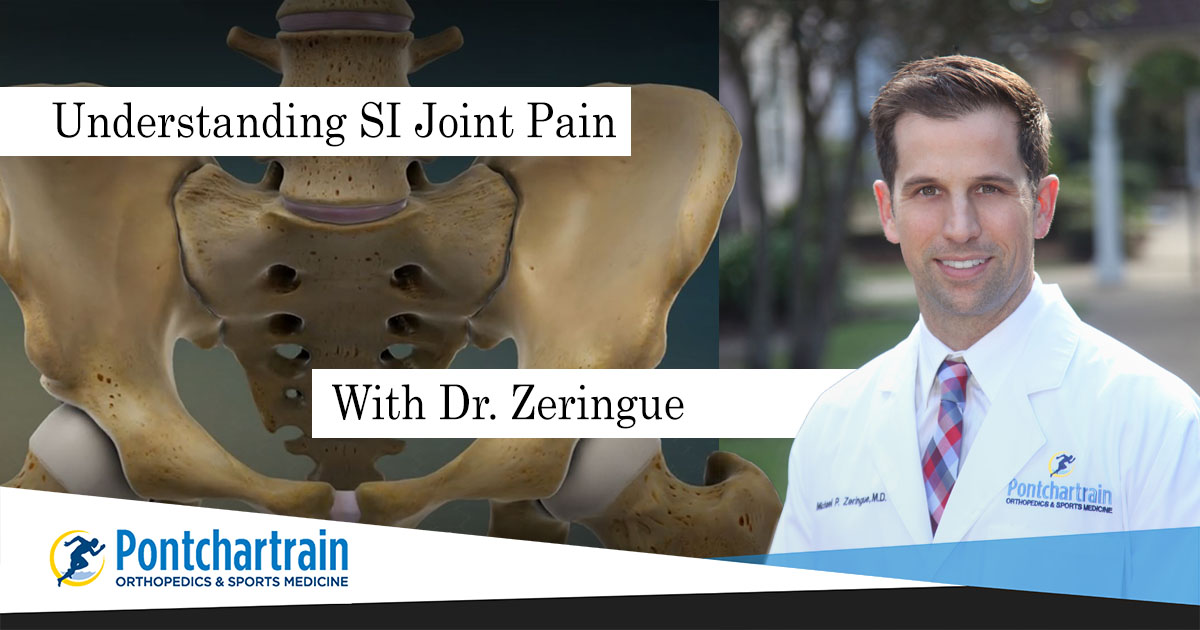Understanding SI Joint Pain

Sacroiliac (SI) joint pain occurs in the lower back and hips and can sometimes be difficult to diagnose. Today, Dr. Michael Zeringue discusses what causes SI joint pain and how the physicians at Pontchartrain Orthopedic and Sports Medicine can help treat it.
What is sacroiliac Joint Pain?
The SI joints are located in the pelvis, linking the iliac bone (pelvis) to the sacrum (the lower vertebrae just above the tailbone). As we discussed in our page defining sacroiliac joint pain The SI joints are highly specialized joints that permit stable, flexible support to the upper body. They are essential for effectively transferring loads between our spine and legs. The SI joints play a major role in absorbing impact when we are walking and lifting.
SI joint pain can originate in the ligaments or the SI joint itself. It can sometimes be caused by osteoarthritis of the SI joint. It can also come from the loss of cartilage in the joint space, or it can be a tear in the supportive ligaments that surround the joint. Small tears or movement of the joint -- such as dislocation or rotation -- can cause an irritation. The degree of pain will vary, but it all centers around those three things.
What can lead to SI joint issues?
An SI joint injury can happen from something obvious, like a fall, pregnancy, traumas such as hip fractures, or, obesity. However, SI joint issues can also occur from overuse or underuse. SI joint pain often happens because of the underuse of certain gluteus muscles from sitting all day long or not varying your exercise routines. If you do just inline biking, for example, without other rotation or abduction exercises, it overuses certain muscles and underuses others, so you can get an imbalance. Like most things in the back, it’s commonly a postural or overuse condition. As you start getting later in life, it can be more of an osteoarthritis issue.
Who is most likely to be affected?
SI joint pain is somewhat common in people who have had fusions of the lumbar spine. Fused vertegra create a loss of motion at the point of the fusion. This loss of flexibility can result in stress being transferred to the SI joint. It could also occur in someone with a femoroacetabular impingement (FAI), an issue with the ball and socket joint in the hip. Because these complex structures all work together, a problem with the hip may affect the next joint, which is the sacroiliac joint.
Why is it tricky to diagnose sacroiliac joint pain?
It’s very difficult to diagnose between SI joint issues, sciatica and facet pain. The referral pattern for all of these conditions is in the same area. They all cause pain in the area of the SI joint and down the back of the leg. While there are certain maneuvers that are more common in each of the syndromes, it doesn’t necessarily rule the other ones out.
If you begin to feel pain in your back beneath the “dimples of Venus” in the lower back after a fall or overuse, you may try anti-inflammatory medications and core exercises. If the pain doesn’t go away in a few days, then you should see a physician for an in-depth evaluation and diagnosis.
"It’s very difficult to diagnose between SI joint issues, sciatica and facet pain. They all cause pain in the area of the SI joint and down the back of the leg. "
- Michael Zeringue, MD, MPH
Treatment options for SI joint Issues
We would start the patient on anti-inflammatories and specific physical therapy exercises for their condition. The exercises will vary, depending on the location of the pain, the patient’s history and the physical exam findings. Sometimes we will prescribe exercises that treat all possible issues.
If physical therapy, medication and anti-inflammatories do not provide relief, we would try an injection of steroids and an anesthetic into the SI joint.
If the injection helps but doesn’t give long-term relief, we would do a diagnostic injection of numbing medicine to confirm that, for those few hours that the numbing medicine is working, they get relief. If that’s the case, they may be a good candidate for Radiofrequency Ablation (RFA), a process in which the nerves that go to the joint are cauterized to block pain signals.
In very resistant cases, we may recommend a fusion of the SI joint as a last resort.
Have questions about SI joint discomfort?
Today’s post covers the basic questions Dr. Zeringue hears about SI joint pain, but each case is unique. If you have other questions or concerns or think that you may have an SI joint problem, contact us today to schedule an appointment. We have two convenient locations available to see you.
About the Doctor
 Michael Zeringue, MD, MPH is a triple board certified physician in Pain Management, Sports Medicine and Family Medicine and specializes in interventional spine and ultrasound guided injections. Dr. Zeringue earned his medical degree from Tulane University in New Orleans and completed his internship and residency in Family Medicine at John Peter Smith Hospital in Fort Worth, Texas. Following residency Dr. Zeringue finished two separate fellowships in Sports Medicine and Pain Management. He is a life long resident of the New Orleans area and served for several years as team physician for Brother Martin High School in New Orleans.
Michael Zeringue, MD, MPH is a triple board certified physician in Pain Management, Sports Medicine and Family Medicine and specializes in interventional spine and ultrasound guided injections. Dr. Zeringue earned his medical degree from Tulane University in New Orleans and completed his internship and residency in Family Medicine at John Peter Smith Hospital in Fort Worth, Texas. Following residency Dr. Zeringue finished two separate fellowships in Sports Medicine and Pain Management. He is a life long resident of the New Orleans area and served for several years as team physician for Brother Martin High School in New Orleans.
This website is not designed to and does not provide medical advice, medical diagnosis, professional opinion, treatment or services to you or any other person. Through this website and links to other websites, Pontchartrain Orthopedics & Sports Medicine provides general information for educational purposes only. The information provided in this website, or through links to other sites, is not a substitute for medical care. You should not use this information in place of a visit, call, consultation or the advice of your healthcare provider. Pontchartrain Orthopedics & Sports Medicine is not liable or responsible for any advice, course of treatment, diagnosis or any other information, services or product you obtain through this site.
